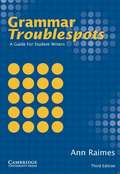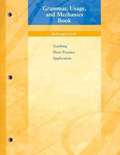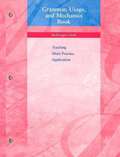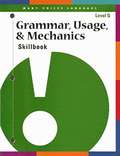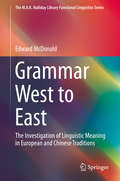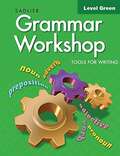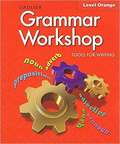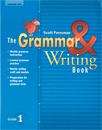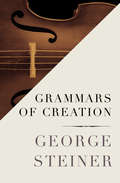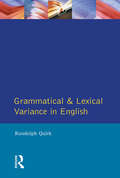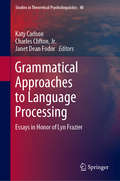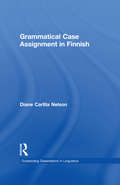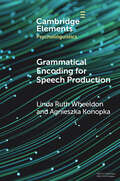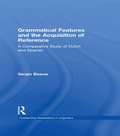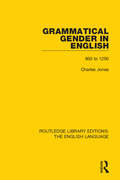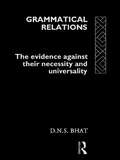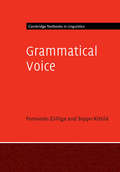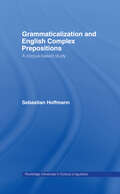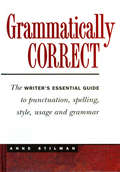- Table View
- List View
Grammar Troublespots: A Guide For Student Writers
by Ann RaimesA new edition of Grammar Troublespots providing an excellent aid for student writers at the high-intermediate level and above. The Student's Book helps them identify and correct the errors that they are likely to make as they write. The emphasis in this new edition is on errors made in writing formal academic discourse. The book has 21 units. Each one examines an area of grammar, such as verb tense choice, article usage, and modals, and then pinpoints the most troublesome grammar points within that area. Each unit provides a straightforward description of the grammar point, supported by clear examples, grammar charts, and tables. The two-color new edition is easy to use, with exercises such as error identification, error correction, and sentence construction tasks, consistently following each grammar point. Each unit ends with a writing assignment and a flowchart to help students diagnose their writing problems and edit their writing.
Grammar, Usage, and Mechanics Book, Grade 7: Teaching More Practice Application
by McDougal-Littell Publishing StaffGrammar, Usage, and Mechanics Book Grade 7 contains a wealth of skill-building exercises. Each lesson has different levels of worksheets. Teaching introduces the skill; More Practice and Application extend the skill with advanced exercises. Each page focuses on one topic or skill. A brief instructional summary on the Teaching page is followed by reinforcement activities. Key words and phrases are highlighted for greater clarity and ease of use. When appropriate, example sentences demonstrate how to complete exercises.
Grammar, Usage, & Mechanics Skillbook (Many Voices Language Series)
by Perfection LearningPractice lessons that align with grammar, usage, and mechanics shapers in The Essential Guide to Language, Writing, & Literature, Red Level. This book may also be used as a stand-alone workbook.
Grammar (Volume IV)
by ChapmanStudents of the English language will welcome this comprehensive course which will help them express themselves intelligently and effectively in speech and writing. The difficulties experienced by students in grasping the niceties and finer points of “good English” have been taken into account. Valuable aids to accuracy and elegance in expression are offered. The author, an experienced Teacher of English, having studied under an outstanding Jesuit Teacher from England, brings the rich fund of his practical knowledge to bear on the problems that confront Indian students in mastering what to them is essentially a foreign language. The dry bones of words, phrases, idioms, and grammatical usage have been clothed with “flesh and blood” and given life, in practical examples.
Grammar West to East: The Investigation of Linguistic Meaning in European and Chinese Traditions (The M.A.K. Halliday Library Functional Linguistics Series)
by Edward McDonaldThis book compares the historical development of ideas about language in two major traditions of linguistic scholarship from either end of Eurasia – the Graeco-Roman and the Sinitic – as well as their interaction in the modern era. It locates the emergence of language analysis in the development of writing systems, and examines the cultural and political functions fulfilled by traditional language scholarship. Moving into the modern period and focusing specifically on the study of “grammar” in the sense of morph syntax/ lexico grammar, it traces the transformation of “traditional” Latin grammar from the viewpoint of its adaptation to Chinese, and discusses the development of key concepts used to characterize and analyze grammatical patterns.
Grammar Workshop™: Tools for Writing, Level Green
by Beverly Ann ChinThe consumable Student Edition helps students master grade-appropriate conventions of standard English through instruction with models, ample practice, and immediate application of skills. Divided into six units, each level focuses on teaching the conventions of standard English–grammar, usage, and mechanics–as well as, the writing process and grammar in the context of reading and writing. <p><p>Each lesson has the same three-step instructional sequence: <p><p> • Learn features skill instruction with clear explanations and modeling <p><p>• Practice includes three scaffolded activities, each building on the prior and increasing in difficulty <p><p>• Write lets students apply what they learned by revising sentences, combining sentences, and writing on their own <p><p>Engaging new online games and activities will enhance student learning.
Grammar Workshop: Tools for Writing
by Sadlier2021 Sadlier Grammar Workshop Tools For Writing, grade 4
Grammar Workshop Tools for Writing: Grade 5
by Beverly Ann Chin Elaine M. Czarnecki Kerry A. VannGrammar Workshop Tools for Writing Grade 5
Grammars of Approach: Landscape, Narrative, and the Linguistic Picturesque
by Cynthia WallIn Grammars of Approach, Cynthia Wall offers a close look at changes in perspective in spatial design, language, and narrative across the late eighteenth and early nineteenth centuries that involve, literally and psychologically, the concept of “approach.” In architecture, the term “approach” changed in that period from a verb to a noun, coming to denote the drive from the lodge at the entrance of an estate “through the most interesting part of the grounds,” as landscape designer Humphrey Repton put it. The shift from the long straight avenue to the winding approach, Wall shows, swung the perceptual balance away from the great house onto the personal experience of the visitor. At the same time, the grammatical and typographical landscape was shifting in tandem, away from objects and Things (and capitalized common Nouns) to the spaces in between, like punctuation and the “lesser parts of speech”. The implications for narrative included new patterns of syntactical architecture and the phenomenon of free indirect discourse. Wall examines the work of landscape theorists such as Repton, John Claudius Loudon, and Thomas Whately alongside travel narratives, topographical views, printers’ manuals, dictionaries, encyclopedias, grammars, and the novels of Defoe, Richardson, Burney, Radcliffe, and Austen to reveal a new landscaping across disciplines—new grammars of approach in ways of perceiving and representing the world in both word and image.
Grammars of Creation: Originating In The Gifford Lectures For 1990
by George Steiner"A fresh, revelatory, golden eagle's eye-view of western literature." --Financial TimesEarly in Grammars of Creation, George Steiner references Plato's maxim that in "all things natural and human, the origin is the most excellent." Creation, he argues, is linguistically fundamental in theology, philosophy, art, music, literature--central, in fact, to our very humanity. Since the Holocaust, however, art has shown a tendency to linger on endings--on sundown instead of sunrise. Asserting that every use of the future tense of the verb "to be" is a negation of mortality, Steiner draws on everything from world wars and the Nazis to religion and the word of God to demonstrate how our grammar reveals our perceptions, reflections, and experiences. His study shows the twentieth century to be largely a failed one, but also offers a glimpse of hope for Western civilization, a new light peeking just over the horizon.
Grammatical and Lexical Variance in English
by Randolph QuirkWritten by one of Britain's most distinguished linguists, this book is concerned with the phenomenon of variance in English grammar and vocabulary across regional, social, stylistic and temporal space.
Grammatical Approaches to Language Processing: Essays In Honor Of Lyn Frazier (Studies in Theoretical Psycholinguistics #48)
by Janet Dean Fodor Charles Clifton Katy CarlsonThis book contains papers that were written to honor Professor Lyn Frazier on the occasion of her retirement from the University of Massachusetts Amherst. Some were presented at the Lynschrift on May 19-20, 2018; others were written especially for this volume. The papers report original research on, or research-based theoretical analyses of, several of the domains that Professor Frazier contributed to during her career. The volume begins with a brief overview of Professor Frazier's research contributions and an appreciation of the contributions she has made to the field of psycholinguistics and to her students and colleagues. The next several chapters discuss the roles that prosody plays in language processing, and the volume continues with chapters on the topic that established Professor Frazier as a major psycholinguistic theorist, syntactic processing. The volume then explores the roles semantics and pragmatics play in language comprehension, and concludes with reports of applications and extensions of research on language processing. All chapters were contributed by current and former students and colleagues of Professor Frazier in gratitude for the impact she has had on their lives and careers.
Grammatical Case Assignment in Finnish (Outstanding Dissertations in Linguistics)
by Diane C. NelsonFirst Published in 1998. Routledge is an imprint of Taylor & Francis, an informa company.
Grammatical Encoding for Speech Production (Elements in Psycholinguistics)
by Linda Ruth Wheeldon Agnieszka KonopkaDuring the production of spoken sentences, the linearisation of a 'thought' is accomplished via the process of grammatical encoding, i.e., the building of a hierarchical syntactic frame that fixes the linear order of lexical concepts. While much research has demonstrated the independence of lexical and syntactic representations, exactly what is represented remains a matter of dispute. Moreover, theories differ in terms of whether words or syntax drive grammatical encoding. This debate is also central to theories of the time-course of grammatical encoding. Speaking is usually a rapid process in which articulation begins before an utterance has been entirely planned. Current theories of grammatical encoding make different claims about the scope of grammatical encoding prior to utterance onset, and the degree to which planning scope is determined by linguistic structure or by cognitive factors. The authors review current theories of grammatical encoding and evaluate them in light of relevant empirical evidence. This title is also available as Open Access on Cambridge Core.
Grammatical Features and the Acquisition of Reference: A Comparative Study of Dutch and Spanish (Outstanding Dissertations in Linguistics)
by Sergio BaauwThis book discusses to what extent errors young children make with their interpretation of definite articles and pronouns are due to their immature pragmatic skills, and to what extent incomplete syntactic development plays a role.
Grammatical Gender in English: 950 to 1250 (Routledge Library Editions: The English Language #14)
by Charles JonesFirst published in 1988, this book explores the grammatical loss of gender in English. It demonstrates that from the end of the Old English period, there was a considerable time period, of about three hundred years, during which there existed "echoes" of the gender classification of nouns. The study records the best known conclusions concerning the behaviour of anaphoric pronouns under grammatical gender "stress" in the late Old English and Middle English periods. It focuses on a discussion of attributive word morphology in the noun phrase.
Grammatical Inference
by Wojciech WieczorekThis book focuses on grammatical inference, presenting classic and modern methods of grammatical inference from the perspective of practitioners. To do so, it employs the Python programming language to present all of the methods discussed. Grammatical inference is a field that lies at the intersection of multiple disciplines, with contributions from computational linguistics, pattern recognition, machine learning, computational biology, formal learning theory and many others. Though the book is largely practical, it also includes elements of learning theory, combinatorics on words, the theory of automata and formal languages, plus references to real-world problems. The listings presented here can be directly copied and pasted into other programs, thus making the book a valuable source of ready recipes for students, academic researchers, and programmers alike, as well as an inspiration for their further development. >
Grammatical Relations: The Evidence Against Their Necessity and Universality (Theoretical Linguistics Ser.)
by D. N. BhatThis book argues that the assumption that grammatical relations are both necessary and universal is an unwarranted generalization. The grammatical relations of subject and object are required in the case of the Indian language of Kannada. Furthermore, the notion of transitivity or transference which forms the basis for postulating grammatical relations does not play the expected central role in all languages: in the case of another Indian language, Manipuri, it is volitionality and transitivity which plays the central role in clause structure. Dr. Bhat argues against the universality and necessity of grammatical relations; his provocative hypothesis will be a challenge to all those concerned with the nature of language.
Grammatical Variation in British English Dialects
by Benedikt SzmrecsanyiVariation within the English language is a vast research area, of which dialectology, the study of geographic variation, is a significant part. This book explores grammatical differences between British English dialects, drawing on authentic speech data collected in over 30 counties. In doing so it presents a new approach known as 'corpus-based dialectometry', which focuses on the joint quantitative measurement of dozens of grammatical features to gauge regional differences. These features include, for example, multiple negation (e. g. don't you make no damn mistake), non-standard verbal-s (e. g. so I says, What have you to do?), or non-standard weak past tense and past participle forms (e. g. they knowed all about these things). Utilizing state-of-the-art dialectometrical analysis and visualization techniques, the book is original both in terms of its fundamental research question ('What are the large-scale patterns of grammatical variability in British English dialects?') and in terms of its methodology.
Grammatical Voice (Cambridge Textbooks in Linguistics)
by Fernando Zúñiga Seppo KittiläThe grammatical category of voice covers a wide range of phenomena, including causatives, applicatives, passives, antipassives, middles, and others. Drawing on data from over 200 languages, Fernando Zúñiga and Seppo Kittilä illustrate the semantic, morphological, and syntactic variation of voice across languages from a range of families and regions. They approach the topic from a broad and explicit perspective, and discuss a variety of topics that are not always regarded as voice, in order to make a clear and useful conceptual delimitation. Clearly organized and accessibly written, the book will be welcomed by students and scholars of linguistics, especially those interested in how grammatical categories work.
Grammaticalization
by Paul J. Hopper Elizabeth Closs TraugottGrammaticalization refers to the change whereby lexical terms and constructions serve grammatical functions in certain linguistic contexts and, once grammaticalized, continue to develop new grammatical functions. Paul Hopper and Elizabeth Traugott synthesize research from several areas of linguistics in this revised introduction to the subject. The book includes substantial updates on theoretical and methodological issues that have arisen in the decade since the first edition, as well as a significantly expanded bibliography. Particular attention is paid to recent debates over directionality in change and the role of grammaticalization in creolization. First Edition Hb (1993): 0-521-36655-0 First Edition Pb (1993): 0-521-36684-4
Grammaticalization and English Complex Prepositions: A Corpus-based Study (Routledge Advances in Corpus Linguistics #Vol. 7)
by Sebastian HoffmannWhat is a grammatical unit? How does grammatical structure evolve? How can we best investigate the mental representation of grammar? What is the connection between language use and language structure? This book aims to help answer such questions by presenting a detailed analysis of English complex prepositions (e.g. in spite of or with respect to) on the basis of large amounts of authentic language data dating from the Middle Ages until today.
Grammatically Correct: An Essential Guide to Punctuation, Style, Usage and More
by Anne StilmanHow does good writing stand out? If its purpose is to convey facts, findings, or instructions, it need be read only once for its content to be clear. If its purpose is to entertain or to provoke thought, it makes readers want to come back for more.Revised and updated, this guide covers four essential aspects of good writing:Individual words: spelling variations, hyphenation, frequently confused homonyms, frequently misused words and phrases, irregular plurals and negatives, and uses of capitalization and type style to add special meanings. Punctuation: the role of each mark in achieving clarity and affecting tone, and demonstration of how misuses can lead to ambiguity. Syntax and structure: agreement of subject and verb, parallel construction, modifiers, tenses, pronouns, active versus passive voice, and more. Style:advice on the less hard-and-fast areas of clarity and tone, including sentence length and order, conciseness, simplification, reading level, jargon and cliches, and subtlety. Filled with self-test exercises and whimsical literary quotations, Grammatically Correct steers clear of academic stuffiness, focusing instead on practical strategies and intuitive explanations. Discussions are designed to get to the heart of a concept and provide a sufficient sense of when and how to use it, along with examples that show what ambiguities or misinterpretations might result if the rules are not followed. In cases where there is more than one acceptable way to do something, the approach is not to prescribe one over another but simply to describe the options. Readers of this book will never break the rules of language again - unintentionally.
